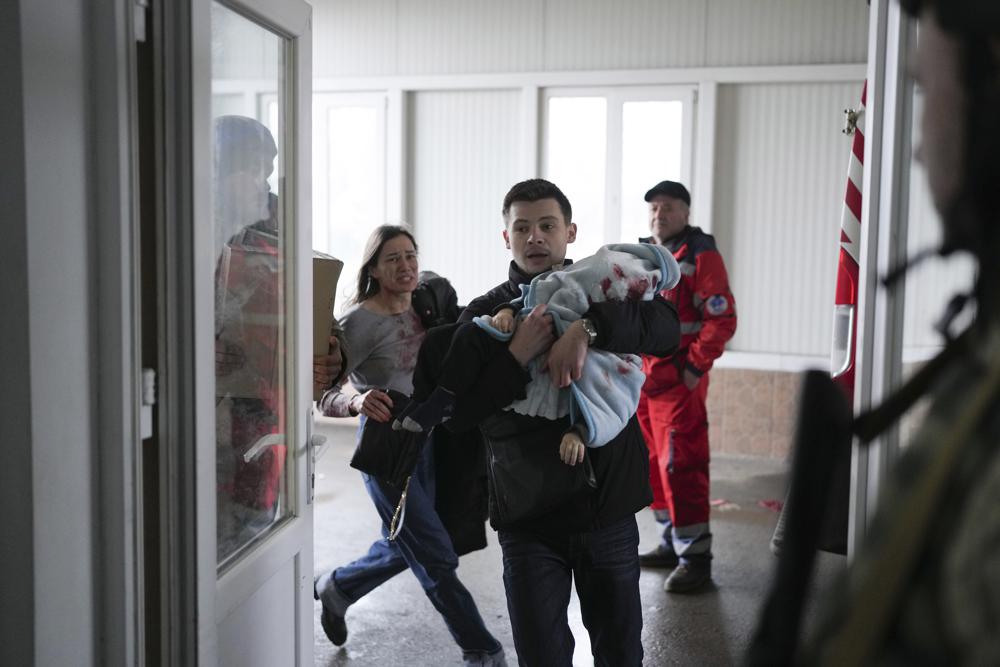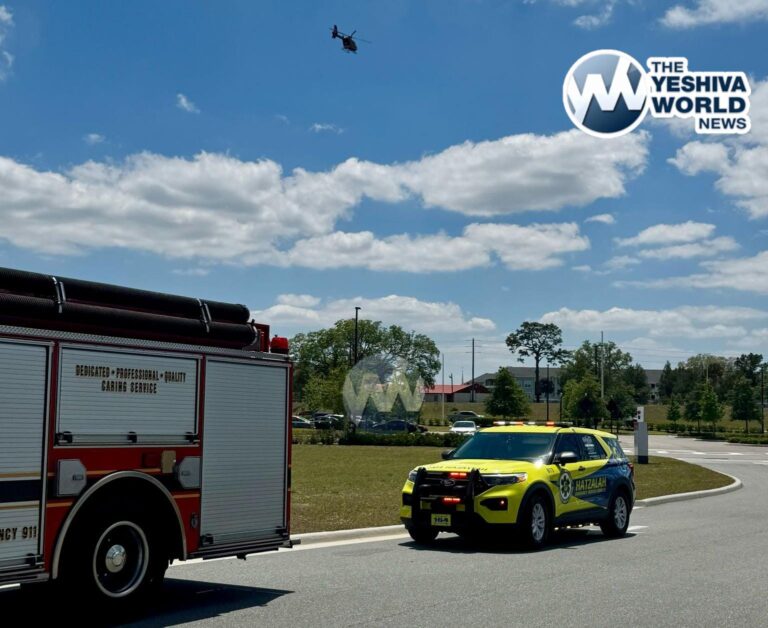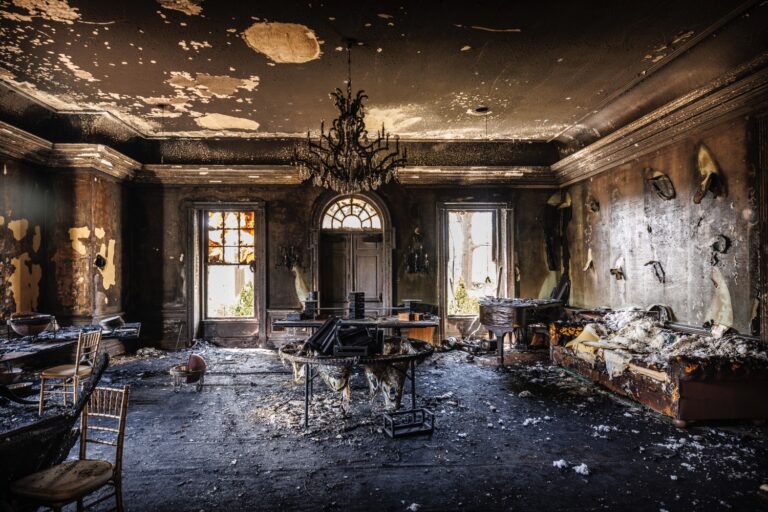A man dashes into a hospital with a desperately wounded toddler in his arms, the child’s mother on his heels. Doctors use smartphone torches to examine patients’ wounds.
New mothers nestle infants in makeshift basement bomb shelters.
A father collapses in grief over the death of his teen son when shelling ravages a soccer field near a school.
These scenes unfolded in and around the Azov Sea port of Mariupol in southern Ukraine over the past week, captured by Associated Press journalists documenting Russia’s invasion.
With nighttime temperatures just above freezing, the battle plunged the city into darkness late in the week, knocked out most phone services and raised the prospect of food and water shortages. Without phone connections, medics did not know where to take the wounded.
A limited cease-fire that Russia declared to let civilians evacuate Mariupol and Volnovakha, a city to its north, quickly fell apart Saturday, with Ukrainian officials blaming Russian shelling for blocking the promised safe passage.
Russia has made significant gains on the ground in the south in an apparent bid to cut off Ukraine’s access to the sea. Capturing Mariupol could allow Russia to build a land corridor to Crimea, which it seized in 2014.
THE PAIN OF MOTHERS
A man dashes through the doors of a hospital carrying a desperately wounded toddler wrapped in a pale blue, bloodstained blanket. His girlfriend, the baby’s mother, is on his heels.
Hospital workers surge round, trying to save the life of 18-month-old Kirill, but there is nothing to be done.
As Marina Yatsko and her boyfriend Fedor weep in each other’s arms, distraught staff sit on the floor and try to recover themselves before the next emergency arrives.
It’s a scene repeated over and over again in Mariupol. Days earlier, hospital workers had pulled a wounded 6-year-old girl from an ambulance as her mother stood alone, helpless.
Multiple attempts at resuscitation failed until eventually the frenetic activity stopped and the mother was left with her grief. A doctor looked straight into the camera of an AP videojournalist allowed inside.
He had a message: “Show this to Putin.”
___
HOSPITAL HAS NO POWER
Smoke from shelling rises over a snow-covered residential part of Mariupol, as in the city’s hospital the bangs send women dropping to the floor for shelter. One raises her arms in prayer.
Doctors use their smartphone torches to examine patients’ wounds, as the hospital lacks electricity and heating.
“We work more than a week without a break, (some of us) even more,” said doctor Evgeniy Dubrov. “(We) continue working, everyone on their positions.”
Grappling with the pain of their wounds, Ukrainian soldiers are in shock at the loss of their comrades.
“I don’t understand what had happened, blast, my eyes getting dark and vison blurring,” said Svyatoslav Borodin. “I continued to crawl … but I didn’t understand if I had legs or not. Then I turned and saw my leg.”
___
DEATH COMES TO A SOCCER FIELD
Flashes from shelling light up the medics as they stand in a parking lot waiting for the next emergency call.
In the hospital nearby, a father buries his face into his dead 16-year-old son’s head. The boy, draped under a bloodstained sheet, has succumbed to wounds from shelling on the soccer field where he was playing.
Hospital staff wipe blood off a gurney. Others treat a man whose face is obscured by blood-soaked bandages.
The medics prepare to go out, strapping on their helmets.
They find a wounded woman in an apartment and take her in an ambulance for treatment, her hand shaking rapidly from apparent shock. She yells out in pain as the medics wheel her into the hospital.
On the darkening horizon, orange light flashes at the edge of the sky and loud bangs reverberate in the air.
___
CHILDREN WILL PLAY
The resting toddler, perhaps responding instinctively to the sight of a camera, raises an arm and waves.
But the mother underneath has tears in her eyes.
They’re lying together on the floor in a gym-turned-shelter, waiting out the fighting that rages outside.
Many families have young children. And as children can do anywhere, some giggle and run around the floor covered with blankets.
“God forbid that any rockets hit. That’s why we’ve gathered everyone here,” says local volunteer Ervand Tovmasyan, accompanied by his young son.
He says locals have brought supplies. But as the Russian siege continues, the shelter lacks enough drinking water, food, and gasoline for generators.
Many there remember the shelling in 2014, when Russia-backed separatists briefly captured the city.
“Now the same thing is happening — but now we’re with children,” says Anna Delina, who fled Donetsk in 2014.
___
TANKS IN A ROW
In a field in Volnovakha on the outskirts of Mariupol, a row of four green tanks hold their cannons at roughly 45 degrees.
Two of them fire, jolting the machines backward slightly, and sending clouds of white smoke skyward.
The tanks are painted with the letter “Z” in white, a tactical sign intended to quickly identify military units and help troops distinguish friend from foe in combat.
The tanks with the “Z” move around inside Russian-held territory and are believed to be used by Russian forces.
___
AMID DEATH, THE JOY OF BIRTH
A nurse fits a shirt on a newborn who fusses at first and then cries loudly. It is a joyful sound.
Babies born at a Mariupol hospital are taken down flights of stairs to a makeshift nursery that also serves as a bomb shelter during shelling.
Sitting in the dimly lit shelter, new mother Kateryna Suharokova struggles to control her emotions as she holds her son, Makar.
“I was anxious, anxious about giving birth to the baby in these times,” the 30-year-old says, her voice shaking. “I’m thankful to the doctors who helped this baby to be born in these conditions. I believe that everything will be fine.”
Above the basement, hospital staff labor to save people wounded in the shelling. A woman with blood streaming from her mouth cries out in pain, A young man’s face is ashen as he is wheeled into the hospital. Another, who did not survive, is covered by a thin blue sheet.
“Do I need to say more?” says Oleksandr Balash, head of anesthesiology department.
“This is just a boy.”
(AP)











